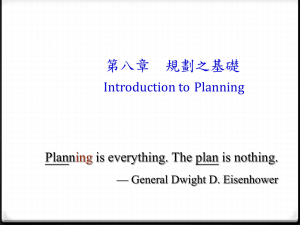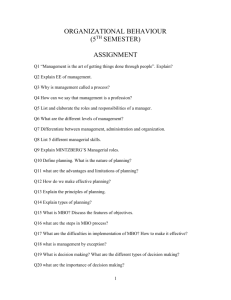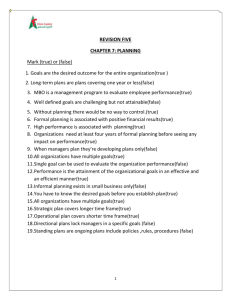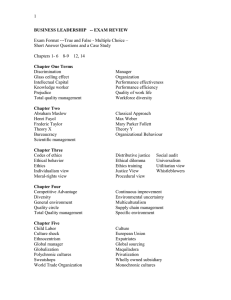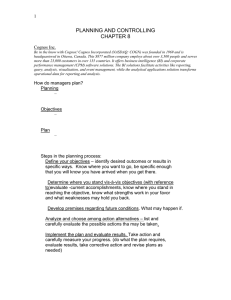تحديد الأهداف
advertisement
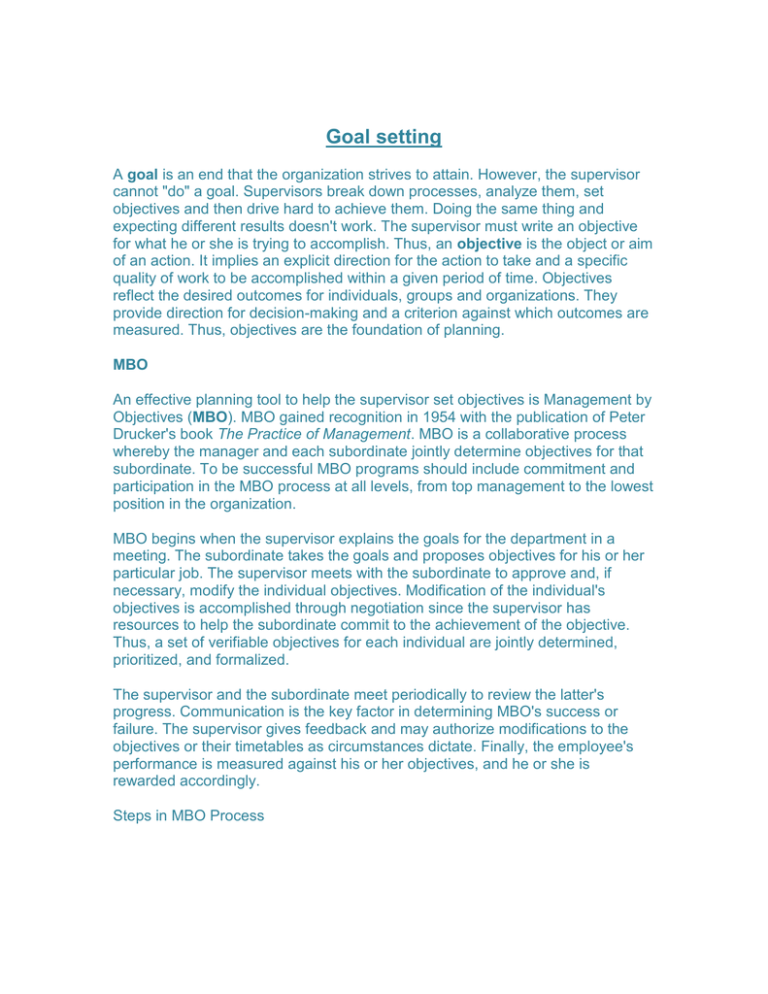
Goal setting A goal is an end that the organization strives to attain. However, the supervisor cannot "do" a goal. Supervisors break down processes, analyze them, set objectives and then drive hard to achieve them. Doing the same thing and expecting different results doesn't work. The supervisor must write an objective for what he or she is trying to accomplish. Thus, an objective is the object or aim of an action. It implies an explicit direction for the action to take and a specific quality of work to be accomplished within a given period of time. Objectives reflect the desired outcomes for individuals, groups and organizations. They provide direction for decision-making and a criterion against which outcomes are measured. Thus, objectives are the foundation of planning. MBO An effective planning tool to help the supervisor set objectives is Management by Objectives (MBO). MBO gained recognition in 1954 with the publication of Peter Drucker's book The Practice of Management. MBO is a collaborative process whereby the manager and each subordinate jointly determine objectives for that subordinate. To be successful MBO programs should include commitment and participation in the MBO process at all levels, from top management to the lowest position in the organization. MBO begins when the supervisor explains the goals for the department in a meeting. The subordinate takes the goals and proposes objectives for his or her particular job. The supervisor meets with the subordinate to approve and, if necessary, modify the individual objectives. Modification of the individual's objectives is accomplished through negotiation since the supervisor has resources to help the subordinate commit to the achievement of the objective. Thus, a set of verifiable objectives for each individual are jointly determined, prioritized, and formalized. The supervisor and the subordinate meet periodically to review the latter's progress. Communication is the key factor in determining MBO's success or failure. The supervisor gives feedback and may authorize modifications to the objectives or their timetables as circumstances dictate. Finally, the employee's performance is measured against his or her objectives, and he or she is rewarded accordingly. Steps in MBO Process Research has demonstrated that when top management is committed and personally involved in implementing MBO programs, they significantly improve performance. This finding is not surprising when one considers that during the MBO process employees determine what they will accomplish. After all, who knows what a person is capable of doing better than the person does him or herself? Objectives are the driver of planning processes. It is imperative that top managers safeguard the intention of their goals to facilitate middle and lower management's effective translation and implementation of them. Objectives guide managerial activities such as budgeting, the development of action plans, staffing, and the purchasing of equipment. The organization's success ultimately depends on the combined outcomes of its objectives. Objectives Most supervisors set objectives, but not with equal skill. Few, who do not correctly write objectives, will reap MBO's full benefits. An objective is simply a statement of what is to done and should be stated in terms of results. A mnemonic aid to write objectives is SMART (Specific, Measurable, Attainable, Result-oriented, Time-limited). Specific An objective must be specific with a single key result. If more than one result is to be accomplished, more than one objective should be written. Just knowing what is to be accomplished is a big step toward achieving it. What is important to you? Once you clarify what you want to achieve, your attention will be focused on the objective that you deliberately set. You will be doing something important to you. Measurable An objective must be measurable. Only an objective that affects behavior in a measurable way can be optimally effective. If possible, state the objective as a quantity. Some objectives are more difficult to measure than others are. However, difficulty does not mean that they cannot be measured. Treatment of salespeople might be measured by looking at the absenteeism and turnover rates among the sales force. Also, salespeople could be asked to fill out a behavioral questionnaire anonymously giving their observations of the supervision they receive. Customer service could be measured by such indices as the number of complaints received, by the number of customers lost, and by customer interviews or responses to questionnaires. Development of subordinates could be measured by determining the number of tasks the subordinate has mastered. Cooperation with other functions could be measured by length of delay in providing requested information, or by peer ratings of degree of cooperation. Avoid statements of objectives in generalities. Infinitives to avoid include to know, to understand, to enjoy, and to believe. Action verbs are observable and better communicate the intent of what is to be attempted. They include to write, to apply, to recite, to revise, to contrast, to install, to select, to assemble, to compare, to investigate, and to develop. How will you know you've progressed? Attainable An objective must be attainable with the resources that are available. It must be realistic. Many objectives are realistic. Yet, the time it takes to achieve them may be unrealistic. For example, it is realistic to want to lose ten pounds. However, it is unrealistic to want to lose ten pounds in one week. What barriers stand between you and your objective? How will each barrier be overcome and within what time frame? Result-oriented The objective should be central to the goals of the organization. The successful completion of the objective should make a difference. How will this objective help the organization move ahead? Is the objective aligned with the mission of the organization? Time-limited The objective should be traceable. Specific objectives enable time priorities to be set and time to be used on objectives that really matter. Are the time lines you have established realistic? Will other competing demands cause delay? Will you be able to overcome those demands to accomplish the objective you've set in the time frame you've established? Write Meaningful Objectives Although the rules are difficult to establish, the following may be useful when writing an objective. 1. Start with an action or accomplishment verb. (Use the infinitive form of the verb. This means to start the with "to.") 2. Identify a single key result for each objective. 3. Give the date of the estimated completion. 4. Be sure the objective is one you can control. 5. To test for validity of SMART objectives, ask yourself the following questions.
